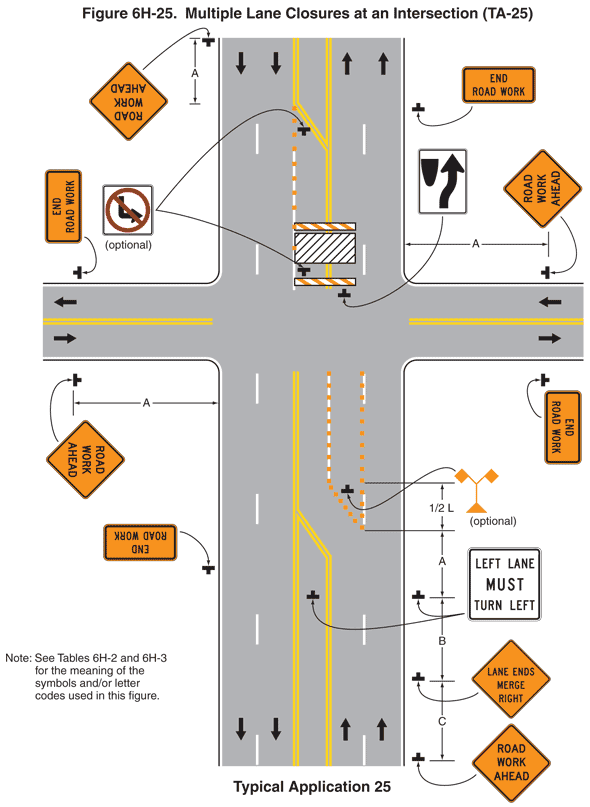|
|
2009 Edition Part 6 Figure 6H-25. Multiple Lane Closures at an Intersection (TA-25)

Figure 6H-25. Multiple Lane Closures at an Intersection (TA-25)
This figure illustrates an example of multiple lane closures at an intersection. A legend under the figure states that this is Typical Application 25. A note states "See Tables 6H-2 and 6H-3 for the meaning of the symbols and/or letter codes used in this figure."
This figure shows a vertical five-lane roadway intersecting a horizontal two-lane roadway. The center lane on the vertical highway is shown marked as a median with solid double yellow lines on both sides in advance of a left-turn lane in both directions. Black arrows on the vertical roadway indicate that the direction of traffic in the two left lanes is southbound and the traffic in the two right lanes is northbound. The same-direction travel lanes on the vertical roadway are shown separated by a broken white line. Black arrows on the horizontal roadway denote that the direction of traffic in the top lane is westbound and in the bottom lane, eastbound.
At the bottom of the figure and to the right of the northbound lanes, a black inverted "T" is shown denoting a sign. The sign is shown as a diamond-shaped orange sign with a black border and the words "ROAD WORK AHEAD" in black. This sign is shown at a dimensioned distance C in advance of another sign to the right of the roadway. This is shown as a diamond-shaped orange sign with a black border and the words "LANE ENDS MERGE RIGHT" in black. This sign is shown at a dimensioned distance B in advance of another sign. This is shown as a square white sign with a black border to the right of the roadway with the words "LEFT LANE MUST TURN LEFT" in black. This sign is shown at a dimensioned distance A in advance of a series of orange squares, denoting channelizing devices. An identical sign is shown just beyond this one in the median at the point where the taper is shown beginning for the left-turn lane. The channelizing devices are shown beginning on the broken white line and continuing straight to the intersection with the horizontal roadway. From their starting point, the devices also are shown tapering to the left for a dimensioned distance L and then straightening again and continuing to the intersection, paralleling the lines of the left-turn lane. In the median created by the channelizing devices, an inverted "T" denoting a flag tree is shown at a dimensioned distance 1/2 L from the beginning of the channelizing devices. A leader to a symbol of an orange flag tree denotes it as optional.
On the far side of the intersection and extending across the left northbound lane and the southbound left-turn lane, a horizontal rectangle is shown with diagonal orange and white stripes, denoting a Type III barricade. A vertical rectangular white sign with a black border is shown on the right front of the barricade, facing northbound traffic. At the top left corner of the sign, a depiction of the plan view of the nose of a traffic island is shown. An upward-pointing arrow is shown on the sign, curving to depict movement to the right of the nose of the island. A square white sign with a black border and labeled optional is shown on the back of the barricade facing southbound traffic. The sign shows a vertical black arrow bent at a 90-degree angle pointing to the left. A red circle and diagonal slash running from the upper left to the lower right are shown superimposed on the arrow, denoting no left turn, The barricade is shown in advance of a horizontal rectangle with black and white diagonal stripes, denoting a work space, that is shown the width of the two lanes. Another barricade is shown on the north side of the work space. Beyond the work space, a horizontal rectangular orange sign with a black border is shown to the right of the northbound roadway with the words "END ROAD WORK" in black.
At the top of the figure and to the right of the southbound lanes on the vertical roadway, a Road Work Ahead sign is shown. This sign is shown at a dimensioned distance A opposite the End Road Work sign to the right of the northbound lanes. Near the top of the figure, the median is shown in advance of the southbound left-turn lane. Where the turn lane begins, a No Left Turn symbol sign labeled optional is shown at the beginning of the taper for the turn lane. A series of channelizing devices is shown extending along the solid double yellow line and continuing straight to the intersection, passing the work space on the right. On the south side of the intersection, an End Road Work sign is shown to the right of the roadway facing southbound traffic.
On the horizontal roadway to the right of the intersection, an End Road Work sign is shown on the south side of the roadway facing eastbound traffic. On the north side of the roadway, a Road Work Ahead sign is shown facing westbound traffic at a dimensioned distance A in advance of the intersection. On the west side of the intersection, an End Road Work sign is shown facing westbound traffic on the north side of the roadway. On the south side of the roadway, a Road Work Ahead sign is shown facing eastbound traffic at a dimensioned distance A in advance of the intersection.
